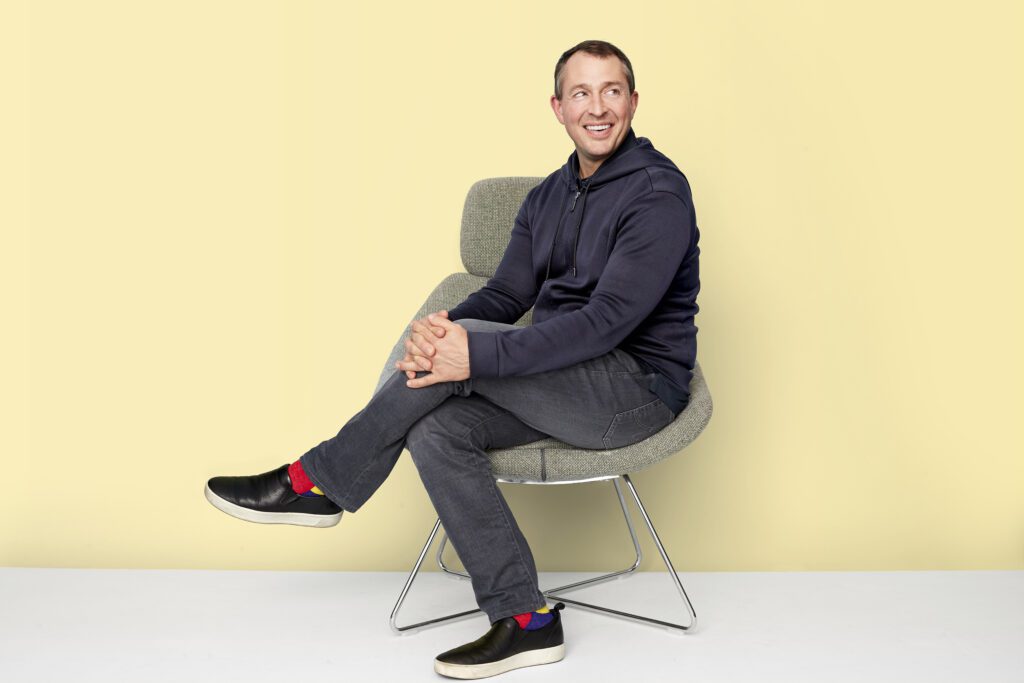ServiceNow on leading at speed: “We broke a ton of stuff along the way”
To succeed in real-time, you need to be agile, iterate, fail, and pick yourself back up again.
Why You Should Care
ServiceNow's Blake McConnell on helping customers navigate the ever-changing world of work during the global pandemic.
The startup mentality: speed, agility, iteration, failure, and disruption.
Why HR teams should focus on facilities and workplace management in 2021.
How do you plan for a post-pandemic world when your end-game keeps moving? Ongoing COVID-19 disruption and the remote work revolution mean we’re more reliant on smart software than ever before and it’s looking like most industries will never go back to full-time office life.
With vaccination programs picking up speed and ServiceNow’s Vaccine Administration Management app making headlines a few weeks ago, HR departments and leadership teams are now tasked with figuring out what the eventual return to the workplace might look like for employees and employers.
We spoke with Blake McConnell, Senior Vice President of Employee Workflow Products at ServiceNow, about his learnings and advice on forecasting the employee experience of the future, launching innovative new technology solutions every two weeks, and leading a team at the forefront of the COVID-19 fight.

“It’s pretty amazing and humbling to be associated with our vaccination product and to see the adoption in the marketplace for the new technology which is helping customers, employees, and citizens,” McConnell says at the start of our conversation.
He’s clearly been in the front seat of a rollercoaster for the past year and he’s buzzing from the adrenaline rush.
“This time last year I still had the same title running Employee Workflows. At the time Employee Workflows really was our product for HR; service delivery for HR organizations, helping HR organizations engage employees on service requests, questions, and a pretty good business with really interesting technology and infrastructures,” he notes, adding that the business was already aware that the employee journey transcended HR.
“An employee will engage across the enterprise, with facilities, legal, finance and that was kind of the pivot we were making. Then when COVID-19 hit everybody had to stay at home. So we had to move fast to figure out what we needed to do about this.
“Back in March, I worked on the COVID-19 response apps. Then, when we got to May, lots of organizations became focused on how to get employees back into the workplace,” McConnell explains, adding, “So we said we would think about the applications organizations would need to bring employees back into the workplace. So from mid-May, we didn’t have anything for this, we were just creating new apps on the platform.”
The need for speed
Speed was of the essence. With most of the world’s workforce working remotely, ServiceNow knew it needed to provide solutions — and fast.
User feedback about what worked and what didn’t would be key in the ongoing development of solutions.
“We knew we needed to move pretty fast so wanted to get some new apps out there and get some feedback, iterate, get some feedback, and so on,” McConnell explains.
“So from then on, we moved to a place where we could release new apps every two weeks. We’ve stayed on that cadence and now have had around 16 or 17 releases to date which in the world of ServiceNow is super dramatic. Historically we’d release every six months as a company,” he says.
“We broke a ton of things in the process because the go-to-market wasn’t set up for this, the delivery wasn’t set up for this. But customers told us they needed this and we needed it to stay ahead of the next change,” McConnell adds.
A two-pronged strategy
As a result of the iteration process, McConnell says the business realized it had to serve two categories: is your workforce ready and is your workplace ready to accept the workforce.
Workforce readiness, McConnell adds, centred a lot around surveys: “We figured companies really didn’t know how to communicate with their employees and we learned a lot about that from our emergency response.”
According to McConnell, businesses didn’t know how to reach out and find their employees, but at the same time, they wanted to ask ‘Hey, are you safe? Can you report back? What’s your situation?
Organizations didn’t know how to communicate with their employees in a bi-directional manner:
“HR teams can push information out to employees easily, but often they don’t have a good way for workers to contact them back.
McConnell says they started a survey-dialogue with employees and then looked at health attestation, which included questions around whether an employee had a temperature, a cough, or had been exposed to anyone who’d tested positive for the virus.
It was a matter of canvassing employees about their readiness to return. Then, McConnell says they had to figure out if the workplace was actually ready to welcome them back safely.
Unsurprisingly, many of the questions revolved around Personal Protective Equipment (PPE) and whether organizations could easily meet the demand.
Other key questions included the ability to deal with booking systems for desks and conference rooms as well as the ability to automate cleaning activities to ensure shared spaces were fully disinfected.
“Those two categories proved pretty decent so we just kept iterating on them,” McConnell adds.
Category three – The new normal
The third category, the ‘new normal,’ was all about ensuring businesses operations could meet new needs.
“So contract tracing, from a case management capability, became the focus; this included integrations with the health attestation and knowing who sat where on a given day and getting that into contract tracing system,” he explains.
Businesses also had to be aware of who badged into the building on any given day, and who used the elevator. All of this information and data had to be fed into a contact tracing solution that worked at scale.
Being able to get the bigger picture, not just about which employee came in but also that employee’s entire journey over the course of that day, was key.
“I did a lot of work on integrations with contact tracing, even things like WiFi and Bluetooth networks as we circled in on the employee,” McConnell adds.
After speaking to customers in August 2020, the business realized many clients were looking for a way to get their salespeople back on planes. “They said that, based on stats they’d seen, they were comfortable with that and needed to track where they were going and who they were meeting and traveling with.”
To navigate this challenge, McConnell explains that they needed to create a travel safety app. This way, employees could register and supply critical information and do the health attestation before, during, and after travel.
Around this time, employers also started pushing employees to get regular COVID-19 testing, so McConnell’s team created an app to allow them to do this.
This information is hugely beneficial for workplace administration teams as it enables them to gauge the extent to which the office is safe for employees and to place that data in a contract tracing system.
It’s worth noting that not all of McConnell’s ideas came to fruition. A lot of his work required balancing what people thought they wanted, versus what was actually realistic.
Big data, bigger learning
COVID-19 has likely transformed the way in which organizations will look at iteration and failure going forwards.
“Organizations must recognize the desire to focus on velocity: We wanted to get the product out quickly, to get feedback quickly, and to get it back into the product quickly,” McConnell says.
Perhaps the biggest positive to come out of the pandemic is the fact that many leaders and CHROS are openly caring about their people and places more than they ever have before:
“I’m seeing that as the priority now. It makes sense because employees deal with facilities and workplace services.”
McConnell rightly points out that producing enterprise software during a global pandemic comes with its own set of challenges.
But, this concept of speed, and the acknowledgment that the landscape may look entirely different in two weeks or a month, means businesses need to be iterating at speed. If they don’t, they run the risk of launching a product that’s out of date and fails to meet the market’s needs and requirements.
Focus on facilities
McConnell says ServiceNow knew in 2019 that facilities were going to play a key role going forwards.
Armed with the knowledge that this would be a key area of focus, ServiceNow started focusing on this in January 2020 — but it never imagined workplace services would be as critical as it is now. “It [facilities] really is number one now,” says McConnell.
Being able to learn how employees work, where they work, and what habits they have is key. With this in mind, ServiceNow is constantly thinking about interfaces and how to leverage different browsers across devices, as well as how mobile experiences will help shape the employee experience going forward.
“As people probably won’t be in the office five days a week, they may forget where certain things are and might need help getting around. So the importance of workplace services is incredibly important and so is the ability of workplaces services to deal with the change,” he adds.
The key thing to remember is that back in 2019, a workplace administrator probably didn’t need to move a lot of stuff around that often. But as people being to return to work, and businesses begin to find their feet in the hybrid workplace reality, the workplace administrator is going to be dealing with a lot of change with regards to layout, space, movement, and cleaning.
This is very workflow driven. “So formulating that workflow is key,” McConnell concludes.
TOMORROW: In Part Two of our interview with Blake McConnell, we explore his plans for 2021, and how he incorporated his learnings and velocity to encourage organizational teams to pull together.
Sign up to the UNLEASH Newsletter
Get the Editor’s picks of the week delivered straight to your inbox!

Head of Special Projects at UNLEASH
Jennifer Dunkerley is an award-winning editor and senior digital content manager.
Contact Us
"*" indicates required fields
Partner with UNLEASH
"*" indicates required fields
